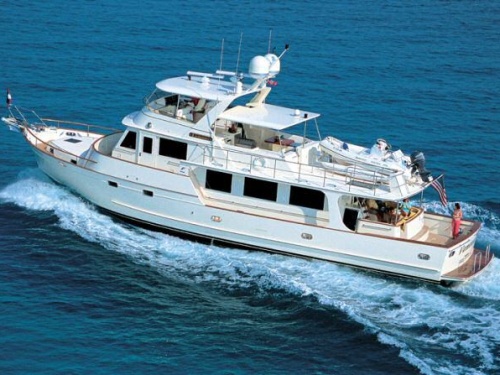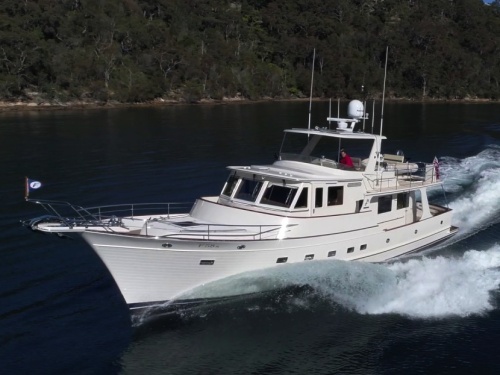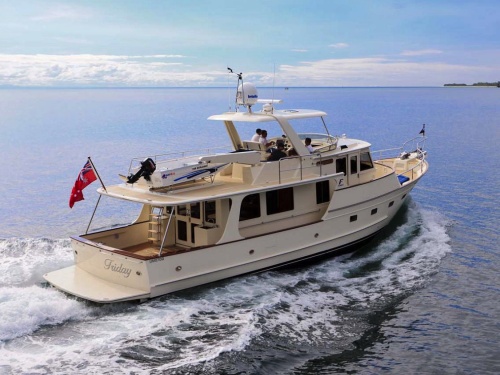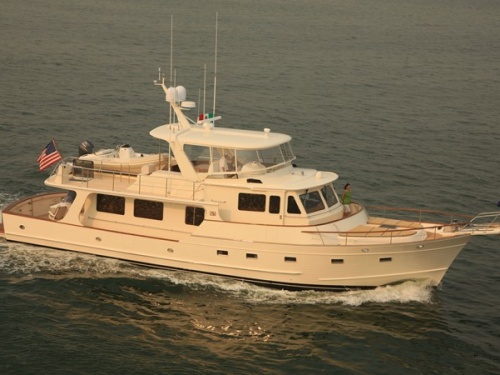Access More Boat Tests
Already have an account? Login
Fleming Yachts 58 (2018-)
2 x i6 MAN 800
Brief Summary
The Fleming 58 is a classic pilothouse trawler design carrying 1,450 gallons (5,489 L) of fuel in two tanks, promising extensive range at displacement speeds.
We tested her with optional 800-hp MAN engines and found her to be more fuel-efficient at displacement speeds than a lighter trawler with a low-hp single engine. And, she can go 20 knots in a pinch.
Key Features
- Cockpit with teak decking
- Integral FRP swim step, molded white non-skid surface and stainless steel telescopic swim ladder
- Stidd double helm seat with footrests and adjustable fore/aft position
- Flybridge L-Settee starboard side with high seat backs
- Satin teak table with Hi-lo and sliding stainless steel pedestal on starboard side
- Two Mastervolt 24v to 12v DC-DC converters with 12v battery back-up system
- Salon entertainment center, teak cabinetry and full length lockers from galley to aft bulkhead
- Forward stateroom tapered queen-sized bed with hydraulic lift and manual slide
Test Results
| RPM | MPH | Knots | GPH | MPG | NMPG | STAT. MILE | NM | dBa |
|---|---|---|---|---|---|---|---|---|
| 700 | 7.4 | 6.5 | 2.5 | 3 | 2.6 | 3873 | 3368 | 60 |
| 1000 | 10 | 8.7 | 6.3 | 1.6 | 1.4 | 2062 | 1793.1 | 64 |
| 1250 | 11.7 | 10.2 | 13.2 | 0.9 | 0.8 | 1155 | 1004.1 | 64 |
| 1500 | 13.1 | 11.4 | 23.7 | 0.6 | 0.5 | 721 | 626.6 | 68 |
| 1750 | 15 | 13 | 36 | 0.4 | 0.4 | 543 | 472.4 | 69 |
| 2000 | 18.1 | 15.8 | 50.9 | 0.4 | 0.3 | 465 | 404.5 | 73 |
| 2250 | 22.4 | 19.5 | 71 | 0.3 | 0.3 | 413 | 358.9 | 74 |
| 2340 | 23.2 | 20.2 | 82.2 | 0.3 | 0.2 | 368 | 320.1 | 74 |

Specifications
| Length Overall |
62' 9" 19.1 m |
|---|---|
| Beam |
17’ 6" 5.33 m |
| Dry Weight |
88,000 lbs. 40,000 kg |
| Tested Weight |
96,290 lbs. 44,583 kg |
| Draft |
5’ 1.52 m |
| Air Draft |
17' 5.18 m |
| Max Headroom |
6' 7" 2 m |
| Fuel Capacity |
1,450 gal. 5,488 L |
| Water Capacity |
320 gal. 1,211 L |
| Total Weight |
96,290 lbs. 44,583 kg |
Acceleration Times & Conditions
| Props | 36d x 34.5p 4 blades |
|---|---|
| Load | 4 persons, 1/2 fuel, 1/2 water, 50 lbs. of gear |
| Climate | 73.8 deg., seas: calm |
Engine Options
| Tested Engine |
2 x i6 MAN 800 |
|---|---|
| Std. Power |
2 x 500-hp Cummins QSC 8.3 L |
 Learn More
Learn More
Watch Our Video

The Fleming 58 is ready for the open ocean and cruising adventures all over the world.
Mission
The mission of the Fleming 58 is unambiguous. She has been designed for a cruising couple that plans to go cruising anywhere in the world and will likely live aboard for three to six months at a time, or even longer. With a full-beam master and two guest staterooms, she is large enough to accommodate adult children and grandchildren or friends on shorter cruises.
Not only was the boat designed for the mission above, but she has also been designed for the person who has that mission in mind — older boaters who have taken a long time to get to this point of their lives and can now enjoy the dream. To that end, the whole boat is designed to be owner-friendly. That means Fleming has built in as many safeguards as possible to keep things from going wrong and make the boat easy to get around on.
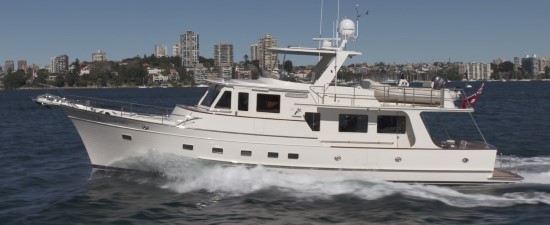
The Fleming 58 has the iconic lines of the brand that have captured the imagination of the cruising world for decades.
This boat is remarkably seaworthy and critical systems have redundancies. Because the boat is designed for short-handed cruising, virtually all systems are easy to use and are highly dependable, but even they have redundancies in most cases.
Only the best equipment and construction materials are used. This boat was not built to a price point. It was built as well as possible for its mission and that has determined its price.
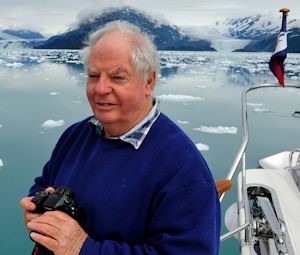
Tony Fleming aboard his Fleming 65 in the high arctic.
Back Story
Fleming Yachts was founded in 1985 by Tony Fleming, who had formerly worked for Grand Banks as its chief engineer and general manager of its yard in the Far East. Fleming had a vision of building long-range cruising yachts for a couple or family that could be lived aboard, that were seaworthy and relatively To In order to build that kind of boat, he formed Fleming Yachts. Shortly after, he introduced the Fleming 55.
Today the company is operated by a small team of British people and one Taiwanese who all have extensive boating and boat-building experience. One of these men is Tony’s nephew and Tony’s daughter, Nicky, is the marketing manager. So, Fleming Yachts is very much a family affair. This is an important element ensuring the quality and functionality of the Fleming yachts.
Tony Fleming is still affiliated with the company and is happily living the dream that he had for so many years. He is cruising the world in his own Fleming 65. His constant feedback to the yard and suggested design innovations to make short-handed operation even easier are prime reasons why Fleming Yachts are so user-friendly.
He also has a terrific eye for boat lines, as his first boat, the Fleming 55 set style that the succeeding three boats have emulated — and it now has an iconic trawler/long-range cruiser look.
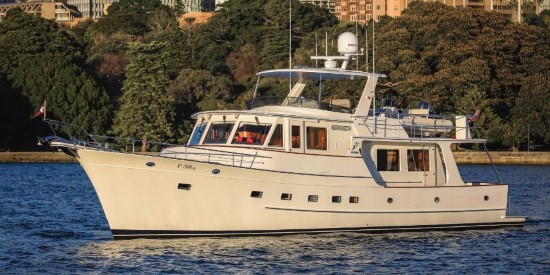
Since 1985, the Fleming lines have cast in the mind’s eye what a true long-range trawler should look like.
Form Follows Function — But Make Her Pretty
There are now four models in the Fleming line — 55, 58, 65, and 78 — and all have the distinctive look of a pilothouse trawler with a high bow, relatively low profile, and pleasing lines. Tony Fleming had been in the boat business long enough to know that boats must not only perform the intended function — but they also must look pretty. After all, who wants to own an ugly boat?
The high, peaked bow stem, sweeping sheer past the pilothouse, the Portuguese bridge and the stepped-down bulwarks aft (which are 28” (71.12 cm high on the 58) present a shippy appearance. But this design is also ideal for the work at hand. The high bow rides over the seas, as it has tremendous buoyancy. Her low CG makes the boat more stable and seaworthy. Several brands have imitated the Fleming look with faux molded in hull planking and general shape, but none — in our opinion — have gotten the proportions just right.
General Layout Plan

The Fleming 58 is 65’9” (19.9 m) from the tip of its bow pulpit to its swim ladder. The hull is 62’9” (19.1 m); the waterline is 56 ’8” (17.3); the beam is 17’6” (5.33 m): the fiberglass keel with 8’ stainless steel shoe, extends 12” (.30 m) below the prop; and she draws 5’ (1.52 m).

Flying bridge: Note that there is a double-wide helm seat so a couple can enjoy piloting the boat together. The tender shown is 13’ (3.6 m).

Main deck: The day head shown here is optional and may be replaced with storage, a dedicated chart table, or additional refrigerator/freezer capacity.

Accommodations deck: Fleming offers three basic plans. This one is the most popular because of the versatility of the forward cabin, which has two separate berths. Bunks can be built in this version that allows four to sleep in the forward cabin — ideal for grandchildren.

This accommodation plan has an island berth forward making it a VIP stateroom. Note that the fuel tanks separate the master stateroom from the engine room.

In this layout option, the master stateroom is forward and the two guest cabins are aft.
What’s the Difference Between the Fleming 55 and 58?
When Fleming first introduced the 58, some people wondered why they would introduce a new boat “only 3’ (0.9 m) longer.” From a distance, it was hard to tell the difference between the two and the two boats have the same basic layout inside. But the length designation is misleading — the Fl8 is really much bigger than it sounds.
First, its hull is actually 7’ (2.1 m) longer than the Fleming 55 – 62’9” (19.13 m) vs. 55’9” (16.99 m). Second, at 88,000 lbs. (39,916 kg) dry, the Fleming 58 actually has 30% more displacement than the 55, at 67,801 lbs. (30,754 kg). The 58 has a 17’6” (5.33 m) beam compared to the 16’ (4.87 m) beam of the 55. And the 58 carries 45% more fuel — 1,450 gallons (5,488 L) compared to 1,000 gallons (3,785 L) for the 55.
Since the 58 is essentially 30% larger, virtually all aspects of the boat are larger, including the staterooms, salon, galley, pilothouse, and flying bridge. 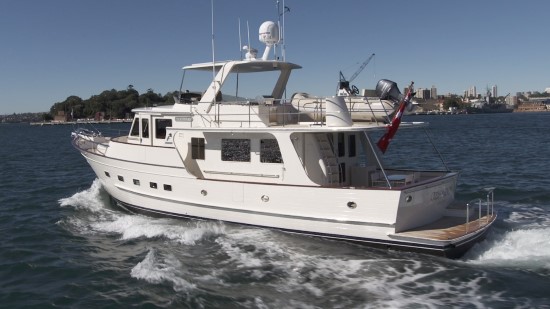
During our sea trial, we noted that the boat was exceptionally quiet, registering only 63.5 dbA at just over 8.5 knots.
Performance Test
The Fleming 58 we tested was powered by the standard inline 6-cylinder MAN i6 800-hp engines driving through Twin Disc Quick Shift marine gears and straight-shaft Seatorque “no-vibration” propulsion systems. The boat’s waterline length is 56’8” (17.3 m) with a beam of 17’6” (5.33 m) and our test weight was estimated to be 96,290 lbs. (43,676 kg). The ambient temperature during testing was 74 degrees F, the wind was 12 knots and seas were under 1’ (.3 m).
At WOT we recorded a speed of 20.2 knots. Since this is a semi-displacement boat, best cruise speed is up to the captain. At 2000 rpm and 15.7 knots the boat burns 50.8 gph for a range of 402 nautical miles, with a 10% fuel reserve. That gives the boat an endurance of 25 hours with a 10% reserve.
So, for running along the coast at 15.7 knots for eight hours, the Fleming 58 can travel 125 nautical miles per day for three days before refueling. That means a delivery trip from Miami to New York City can be made in nine days, at a leisurely pace with time for sightseeing each afternoon in port. Or cruise non-stop at 10 knots and be there in half the time with fuel to spare.
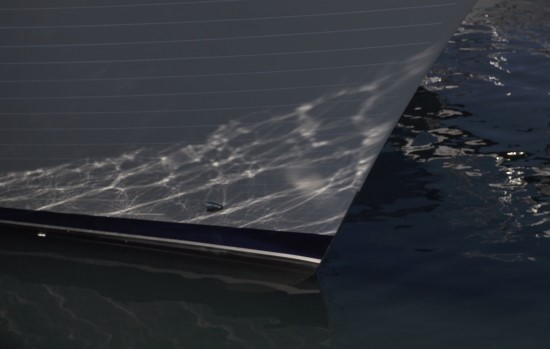
The cutwater of the Fleming 58 is as sharp as on any boat in class and that is one reason that the boat tracks well in a following sea. Note that there are no chines brought forward — they cause the boat to pound in short, steep seas and cause much of the slap-slap-slap-slap when anchored at night.

The Fleming 58 punched right through our photo boat’s wake with authority thanks to her fine entry and 96,000-pound (43,545 kg) displacement on test day. Her ride was smooth and unruffled, but she can throw a lot of water in certain conditions at 20 knots. That is not the name of her game long-range long range cruiser, so that means slower speeds.
Why Two Main Engines?
All Fleming Yachts have two main engines even though these vessels could be propelled at displacement speeds by one relatively small diesel engine. There are several reasons why Fleming builds boats this way, other than the obvious — and important — one of redundancy. Some of those reasons are as follows :
Speed When in Need. Because the 58 is powered by twin MAN 800-ngines, and an owner can put the hammer down if need be in case of emergencies or to outrun some weather.
Fuel Efficiency. At displacement speeds of 7 and 8 knots, the twin 800-hp MAN diesels are just as fuel efficient as a small single diesel or even two small diesels in a similar displacement boat. How could this be? Simply put: it takes only so much horsepower to drive a boat at displacement speeds. When the twin MANs are only turning a 1000 rpm, they are developing only enough horsepower to get the job done literally just lopping along.

At left is Duncan Cowie, who is in charge of the day-to-day operations of Fleming Yachts, and at right is Jeff Hammond, founder of BoatTEST.com. Both men were involved in the speed trials that produced the performance numbers in this report.
A Single-Engine Comparison. In our tests of the Fleming 58, we burned 6.3 gallons total at 1000 rpm and traveled at 8.7 knots. At 951 RPM, we went 8.3 knots and burned 5.3 gph. A silong-rangee long range cruiser displacing about the same amount as the Fleming 58 that we checked with a single 175-hp diesel, had to turn 2100 rpm to go 8.3 knots and burned 6.0 gph in the process. At 8.3 knots, this single-engine boat had to turn 2100 rpm and burned 6.0 gph.
The i6 MAN 800s were more fuel-efficient in total than the low-hp diesel turning high RPM in the 8-knot range.
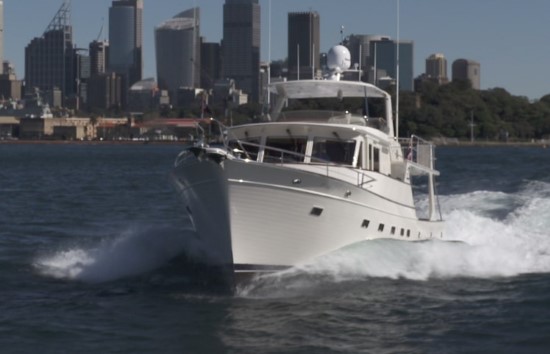
The Fleming 58 approaching WOT during our test runs.
Muscle When Needed. The MAN engines have prodigious torque compared to both the small diesels and even some other larger diesels, according to the folks at Fleming who install eseveral a number of different manufacturers to satisfy owner’s requests. Twins with high torque are important in certain sea conditions, such as, when operating in heavy seas and running nasty inlets. And, when docking, just a quick bump on the throttle will easily move the stern around, one way or the other.
Hydraulics. The 58 we tested was fitted out about as well as one could imagine with not only hydraulic stabilizers but also, hydraulic bow and stern thrusters, and one of the two hydraulic anchor windlasses (the other being powered electrically for redundancy). Both main engine marine gears are fitted with power take-offs (PTOs) which supply each of these important pieces of equipment with reliable hydraulic power.
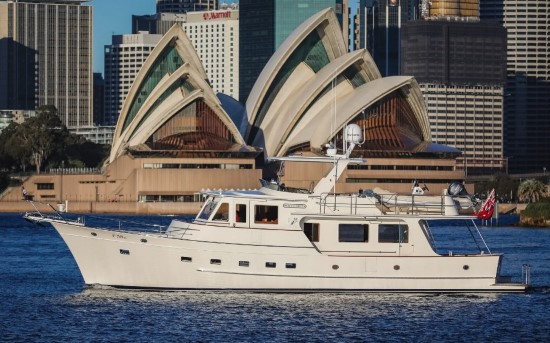
The Fleming 58’s classic lines make her look just as iconic as the Sydney Opera House. While they are completely different functions, once you have seen them, they are never to be forgotten.
Typical Long Range Cruising Operation
The folks at Fleming tell us that owners of their boats typically run them at displacement speeds and set the controls on a fuel consumption number rather than boat speed or RPM setting. They will set the controls to burn 20, 30, or 40 liters per hour, which converts to 5.3, 7.9. and 10.5 gallons per hour.
Based on our test numbers, at 10.5 gph, the Fleming 58 will travel at 9.75 knots and have a range of 1,201 nautical miles with a 10% reserve. At 5.3 gph, the boat will travel 8.25 knots and have a range of 2,033 nautical miles with 10% reserve.
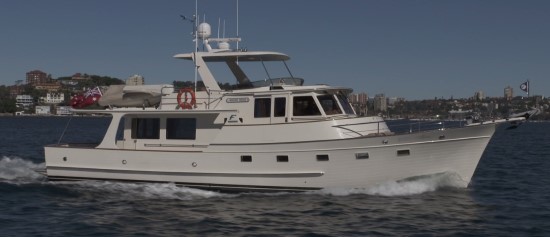
With a bone in her teeth, she can cruise comfortably at 12 to 15 knots and had a WOT speed of 20.2 knots during our test.
Long-Range Cruising Destinations
What all of this means is that because of the Fleming 58’s 1,450-gallon (5,488 L) fuel capacity, almost can go most anywhere except across the Pacific without bladder fuel tanks on deck. The Atlantic can be crossed via Greenland and Iceland with fuel stops well within the 58’s range when taking this northern route. With bladder tanks on the side decks, the 2,200 nautical mile hop from Bermuda to the Azores can be made, and some Flemings have taken that route.
Down Under. In Australia, many Fleming customers take delivery of their boats at Fleming Yachts Australia in Sydney Harbor, a stone’s throw from the Royal Sydney Yacht Squadron. Here, veteran Fleming owner and dealer Egil Paulsen, and Sam Nicholas, will commission the boat. They will also instruct the owner about the cruising grounds of eastern Australia, the lower Indonesian archipelago, the Solomon Islands, and other magical islands to the east.
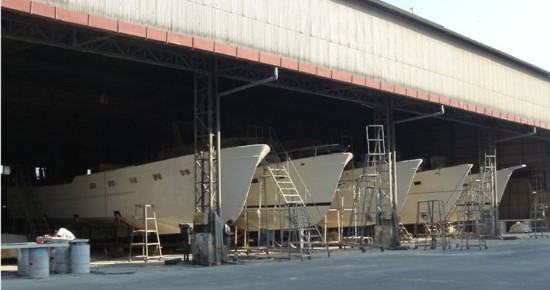
Flemings are built in bays and the interiors are built in situ — the old-fashioned way — and glassed into the hulls, rather than being fabricated in modules that are dropped in. Building in the hull ensures a stronger hull structure as well as a stronger interior that is less likely to suffer damage in challenging conditions, to say nothing of squeaking and groaning in moderate seas.
The Yard that Builds Flemings
All Flemings have been built since 1985 at the family-owned Tung Hwa yard, located near Kaohsiung, Taiwan. The yard only builds Fleming yachts which number about 18 per year. It has a test tank and each boat is placed there, or sea trialed, for extensive testing of all systems before the boat is shipped.
Many of the yard’s shop floor personnel have been at Tung Hwa since the first Fleming was built and they are expert as any craftsmen in the boating business.
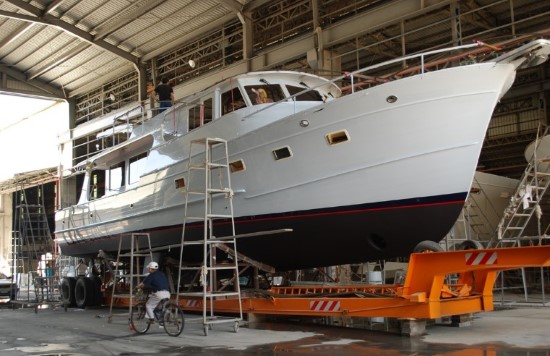
A Flis eming yacht ready to leave the factory to be shipped to her new owner. Taiwan has produced more yachts sold in the U.S. over 50’ than any other country for the last 45 years.
Construction Details
The Hull. The Fleming 58’s hull is solid fiberglass laminate -- it is not cored. In this way, it is far more puncture-resistant than cored hulls, which is one of the priclightweightlight weight. The other is that they can bob like a cork when at rest. The 58’s solid and thick fiberglass hull helps lower her CG and ride better, both underway and at rest.
Vinylester resin is used in the skin layers and then five layers of epoxy are applied to ma absolutely impervious to water migration. The hull has a 5-year gelcoat blister warranty,, but in fact this hull should never have blisters.
Extra layers of lamination are laced in all of the key areas, such as in the bow, the chines, the location of stabzers and in the keel. The keel extends 12” below the props, has an 8’ long stainless steel shoe, is filled with foam, and is completely glassed over on the top, so that the boat has two bottoms, in effect, where the keel is.

The frames and stringers form an egg crate-like structure that keeps the hull rigid, virtually eliminating hull flexing in severe conditions.
Stringers are run the full length of the hull and athwartships frames are both laminated over foam. This is one of the keys to hull integrity as flexing hullseveral a number of problems in the engine room, as well as with the bulkheads and cabinetry.
The hull-to-deck joint is critical because it is vulnerable to stress and can lead to leaks that are difficult to find and repair. Fleming installs a chemical bond both at the deck level and at the top of the bulwark. This chemiis actually stronger than the fiberglass itself, and with two points of sealing instead of the normal one, the chance of leaking is minimized. Fleming says that they have not had one case of hull-deck leakage in all of the boats they have built.
The superstructure is fiberglass using vinylester resin in skin coats, with Corecell M structural foam core material, which has high shear strength and low resin uptake. It is certified by DNV, RINA, Lloyds and ABS. This core material keeps weight down in the structure.
Deck sub-structures are composicoresandwich core with honeycomb for lightweight and stiffness, mucisike what are found on passenger aircraft.
Fleming tells us that all wiring is over-size and exceeds ABYC and CE standards. The company also says that all fuel lines are copper except where flexibility is needed.
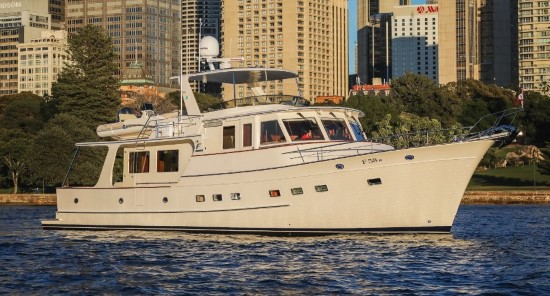
The vessel’s high bow, Portuguese bridge, low CG, and 105,000 lbs. (47,627 kg) displacement when fully laden, make her a comfortable and seaworthy world cruiser.
Fuel tanks are fiberglass made over from a male mold so that the inside is smooth. They have sumps to collect heavier material and particles (which can be drained). Inside, there are baffles to constrain the free surface effect, and there are large ports for cleaning. The two 725-gallon (2,744 L) fuel tanks are laminated with vinylester resin and fire retardant material on the outside. All tanks are pressure tested.
The fuel tanks separate the engine room from the accommodation area, thus creating a natural sound barrier. We prefer fiberglass fuel tanks to aluminum which are often used in tanks in motoryachts. Glass tanks can be glassed into the hull to provide strength and rigidity to the hull and will not come adrift, nor will they corrode as aluminum tanks can, nor will they have leaking welds.
Both fuel tanks have sight gauges, and pressure-type sensors to indicate fuel level on the central monitoring system.
There are two water tanks that are rotomolded polyethylene, and they have sight gauges as well.
Lead-based sound insulation and foam are utilized throughout the engine room, and a soundboard material is used on flat surfaces, including around fuel tanks.
Quiet, Tight Doors and Hatches. All engine room hatches utilize rubber gaskets and are clamped down tight, and all deck hatches have rubber gaskets and mechanisms to keep them tight. Internal doors have rubber molding around the frames to keep them from rattling and contain sound.
Yacht Inspection

The stern platform is integral to the hull which adds waterline length and efficiency as well as providing a good place to step aboard and tie up the tender.
The Stern Platform
The stern platform is full width of the boat at the transom, which is nearly 14’ (4.27 m), and integral to the hull. Its fore and aft measurement is 4’3” (1.29 m) and there is a rail to hold on to along the transom. A step up to the transom door makes entry into the cockpit easy. On the center line under the deck is a 47” telescoping ladder that sets at an angle to make it easier to get up after a swim. A hot and cold freshwater wash down faucet and shore power connection are in hatches on the transom.
Teak is standard on both the cockpit deck and the side decks. It is 5/8” thick and is glued down to the fiberglass deck under a vacuum. This is a bit thicker teak than some builders use, so it will be far more durable and should last decades of cleaning. Teak is also standard on the cap rails, but may be replaced by the optional faux fiberglass cap rail.
Port and starboard are pull-up cleats to tie the painter of a tender.
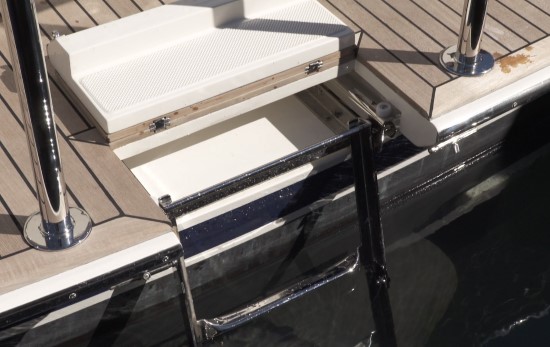
The re-boarding ladder can be reached from the water -- which is an ABYC requirement -- by flipping up the teak deck over it. It extends down 47” at an angle.
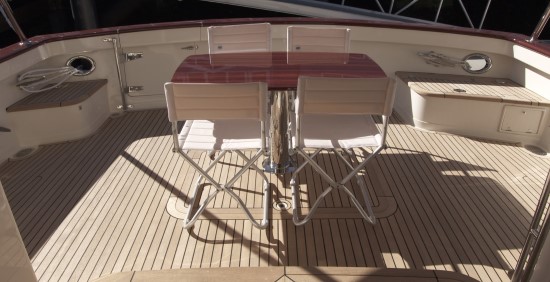
The Fleming 58 we tested had a table mounted on a stainless steel pedestal. Note the boxes in each quarter to aid boarding at a higher dock location. The teak deck is standard.
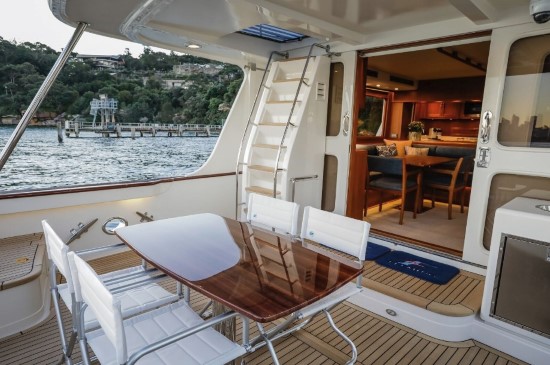
The cockpit is large and can handle any number of activities. We like the overhang as it can be fitted with isinglass to button up the cockpit for three season operation.
Cockpit
The cockpit is over 6’ (1.82 m) fore and aft and 13’6” (4.12 m) wide, which allows enough room for all sort of activities such as entertaining, scuba diving, lounging or even casual fishing. The photo above shows a dining table and four chairs. We could visualize two square tables serving six or eight people. To port are built-in steps with teak treads going to the flying bridge. To starboard is a wet bar with refrigerator.
The overhead is 7’ (2.29 m) and it has been brought nearly all the way back to the transom, providing cover for the whole cockpit. Plexiglas side doors port and starboard block off wind and spray from the side decks.
The important aspect of this cockpit is that it is large and each owner can adapt it to the mission at hand.

In both stern quarters there are raised integral boxes covered in teak to aid boarding from a dock. The large hatch in the center leads to the lazarette.
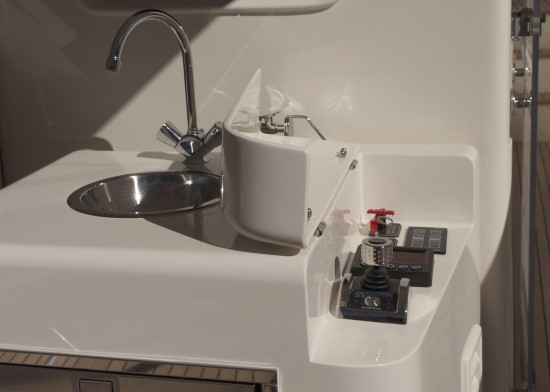
An aft remote control station with a joystick is integral to the wet bar, saving space. Note the emergency engine shut-down device.
Faux Teak Cap Rail. The cap rail and the tabletop on our test boat were not teak, but rather a proprietary fiberglass molding that is nearly indistinguishable from highly varnished teak. Fleming calls this “Burrwood” because the idea for it came from their USA East Coast dealer in the Chesapeake Bay, Burr Yacht Sales.

The thick cap rail looks like genuine teak, but it is fiberglass, thus eliminating maintenance. 80% of Fleming buyers opt for this approach.
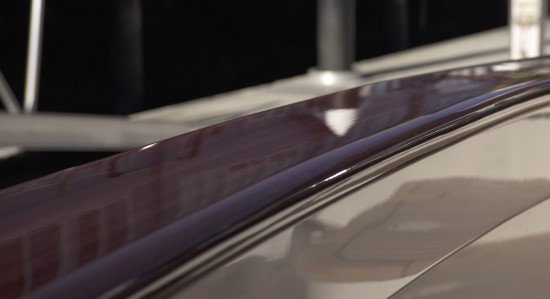
The teak grain is reproduced and the proprietary Fleming cap rail is indistinguishable from the real thing to our eye.
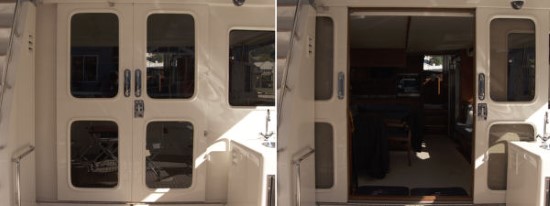
Two doors to the salon slide open independently on roller bearings. When open, the doorway is 46” wide. Clasps automatically hold the doors open.
Salon

The Fleming 58 salon is wrapped in traditional teak which has a timeless nautical look and wears well with age. Note that in this particular vessel, the owner has opted for stools at each end of the table which can be moved when the leaves are out to the inboard side.
Let There Be Teak. Upon entering the salon of the Fleming 58 one is immediately struck by the amount of teak found there. The bulkheads, cabinets, table, entertainment console, and valances are all teak.
The cabin sole sub structure is fiberglass composite honeycomb struction construction with 1/4" teak and holly wood as standard, and many owners add carpet. The windows are large, tempered, and tinted in medium gray. The overhead is upholstered in “Doe” Ultraleather.
The salon serves two purposes: a gathereing area for family and friends to relax and discuss the day’s activities, as well as being the formal dining area. When just the couple is aboard, they may well use the more informal dinette in the pilothouse for lunch and dinner.
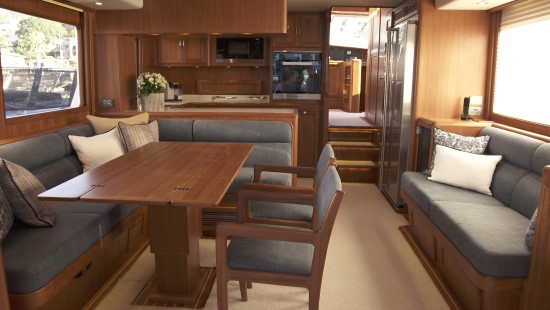
Our test boat had a slightly darker color scheme with an L-shapped settee to port and a sofa to starboard. The deck has carpet over teak and holly, which is an elegant treatment, but practical.

View from the sofa looking to port in the salon.
Entertainment Area. In the starboard aft corner is the entertaimnet center which has a large flatscreen TV on an electric lift so it can be hidden away, and cabinets for hi-fi equipment. To port, is a walk up bar that can be fitted with an icemaker, refrigerator or wine cooler.
On this page we have pictures of the tested boat, but also two other boats to give an idea of the possibilities of other upolstery color schemes, furniture, sconces, and floor treatments.
The standard table is a Fleming design hi-lo table that can be used as a cocktail table or a dining table. Headroom in the salon is 6’7” (2 m).
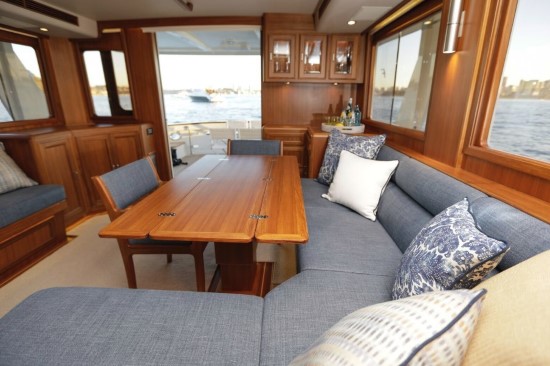
A view aft in our test boat which has an L-shaped settee to port and two conventional chairs. Note the walk-up bar in the background.
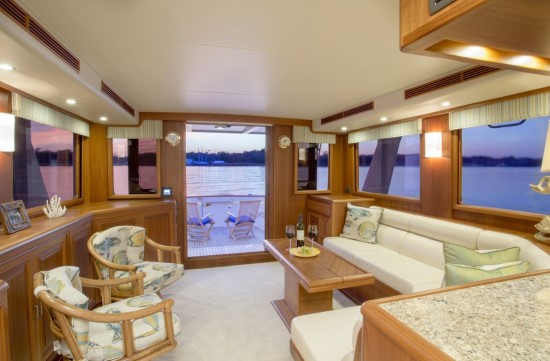
The owner of this Fleming 58 chose not to have a built-in sofa to starboard, opting for storage cabinets and two comfortable Palm Beach-style barrel chairs.
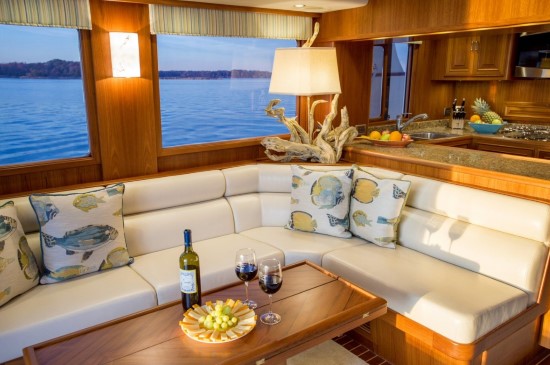
Here we see the table down, ready for a cocktail party. Of course there is storage under the settee.

The flatscreen TV is on an electric lift. Note the AC vents in the overhead which evens out the air flow.
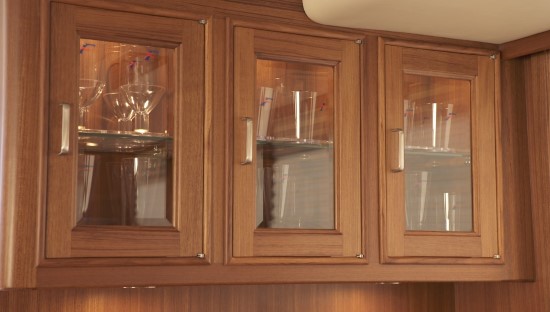
In our test boat, the owner opted to not have a window in the aft bulkhead on the port side next to the walk-up bar. Instead, a cabinet was installed for stemware, and we think it gives the salon a more elegant, genteel look.
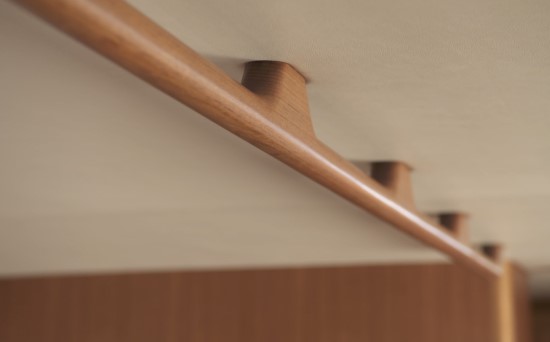
Our test boat had an overhead hand-hold down the centerline of the salon, something all boats in this class should have, but few do. Owners can opt not to have it and some have.
The Galley
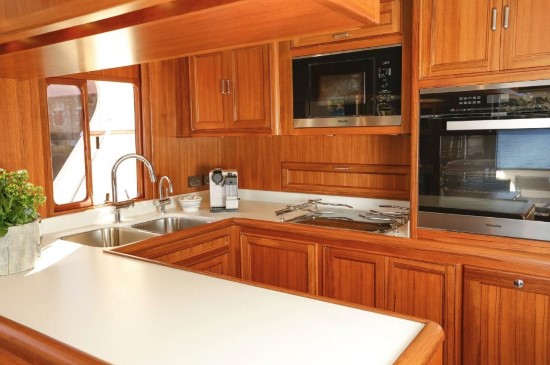
The galley layout is standard for this class of boat but there are small refinements all over that Fleming has made. The left arm countertop measure 21-1/2” x 63”. Plenty of space for food prep.
The alley galley layout is pretty much the standard on this type and size boat, which means it has proven itself on many boats over the years. This design gives the cook three counters to lean against in a sloppy seaway, which is much better than an open L-shaped design.
All cabinet doors are solid teak, not veener. The counter top is granite or Corian, as the owner prefers. The window over the sink opens for fresh air, and there is an exhaust fan over the three-burner Miele induction electric stove top with instant heat. It also has sea rails. It also has stainless steel pot holders, a standard feature on all Flemings.
The stand-up ss refrigerator/freezer on the starboard side is 20.5 cu. ft. Next to it is a full-height pull-out pantry. The dishwasher is next to the sink, and the convection oven and the microwave are both at a proper height so there is no stooping.
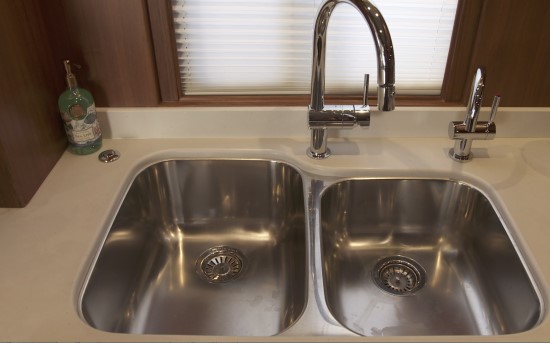
Our test boat had two deep sinks, the smaller one with a standard Insinkerator waste disposal. Note the back splash.
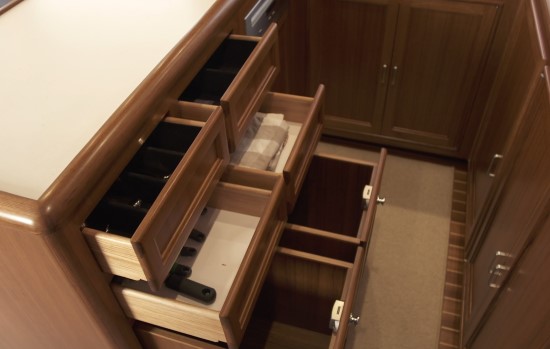
On the left there are six pull-out drawers, the bottom two of which are extra large and have positive German push-pulls. The draws on the top are the nautical lift up and pull design.
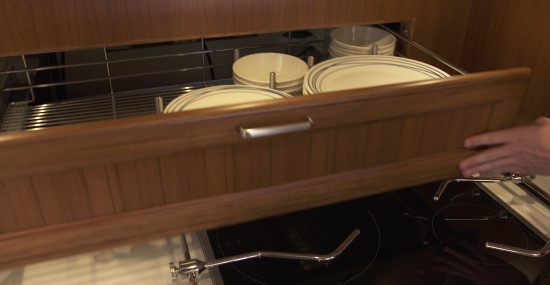
Over the Miele stovetop is a clever drawer for dishes.

A lazy Susan-type cabinet in the outboard corner makes good use of space that would otherwise be wasted.
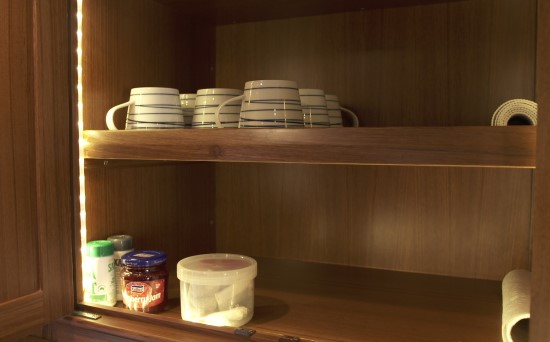
Cabinets over the forward counter are deep and can hold plenty of stores. The rolls at right are the owner’s rubber matting that keeps cups and cans in place surprisingly well (not included).
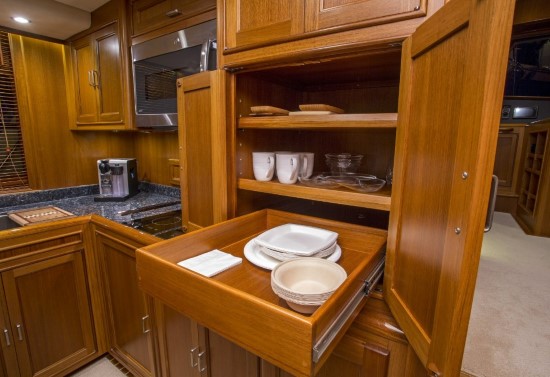
This is the place that some builders put a stand-up refrigerator, but its doors come out in the galley alley restricting movement. This is a much better solution and we like the pull-out drawer in the cabinet.
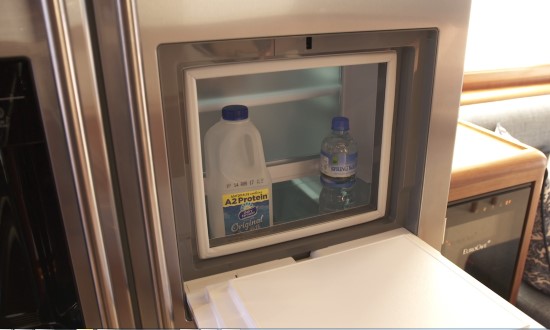
The stand-up refrigerator has a clever little compartment that is accessed by a small door in the large door. It is an ideal place to keep beverages so the refrigerator door does not have to be opened so much. To the right is EuroCave wine cooler which has dual temperatures for white and red wine.
The Raised Pilothouse
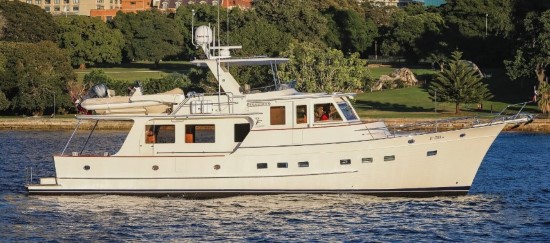
Nothing makes the heart pound faster in a true world cruiser than the sight of a raised pilothouse of a vessel like the Fleming 58.
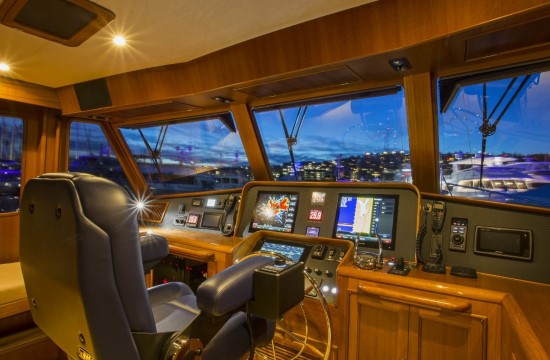
The lower helm on the Fleming 58 is simple and practical, just what one would expect on a seagoing vessel, but not swamped by every electronic gadget on the market. (Many large motoryachts we test have more electronics than many commercial vessels.)
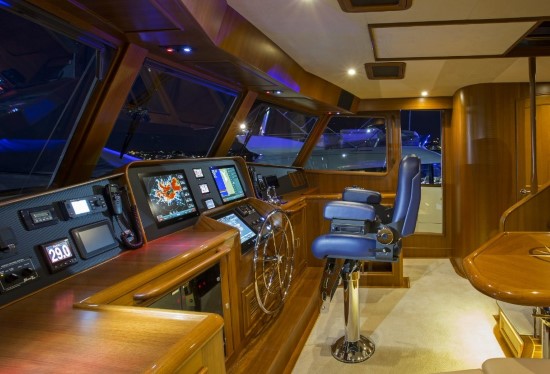
Note that there is only one captain’s chair. We’d like to see another one for the Admiral, as indicated on the drawing at the top of this report. One is available as an option.
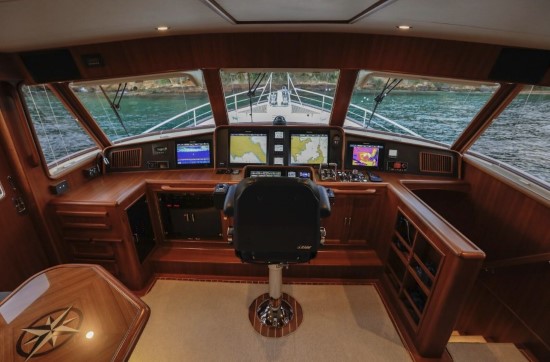
Controls are in the correct position and the helm counter. Behind the twin dark acrylic doors to port of the helm are the 12V and 24V switches. To the left is the AC control panel. Above it is the chart table and the drawers at the far left are deep for charts and chart books. At right is the copanionway to the accommodations deck.
Steering is Important. Fleming uses Hypro Marine ECS Electronic Steering with electronic helm units in the pilothouse and on the flying bridge. Both helms have rudder indicators and there is also a back-up steering panel with a separate power supply, and a dedicated back-up steering pump.
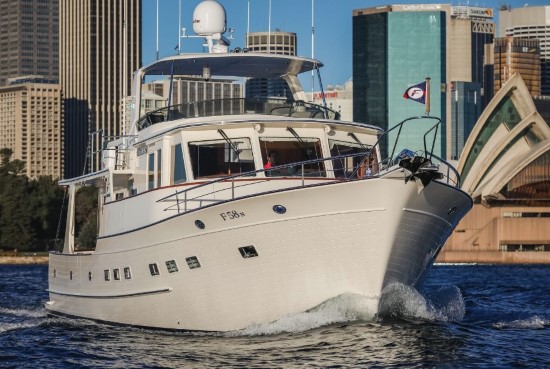
Even from the lower helm in the piloothouse, the Fleming 58 has superb visibility forward as can be seen in this picture taken just off the bow.
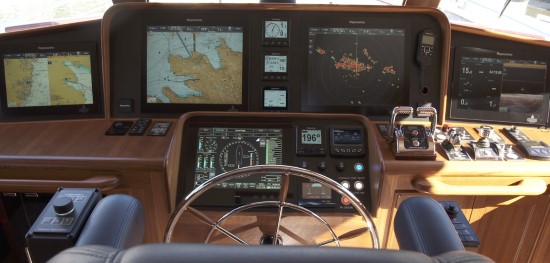
Looking over the back of the Stidd 500XL helm seat upholstered in Ultraleather we see the four screens on the test boat. The Fleming 58 has a hydraulic steering system and a back-up one as well, standard.

Having control of the autopilot and the nav screens from the captain’s chair is the only way to go. It makes for comfortable cruising from 8 to 10 knots.
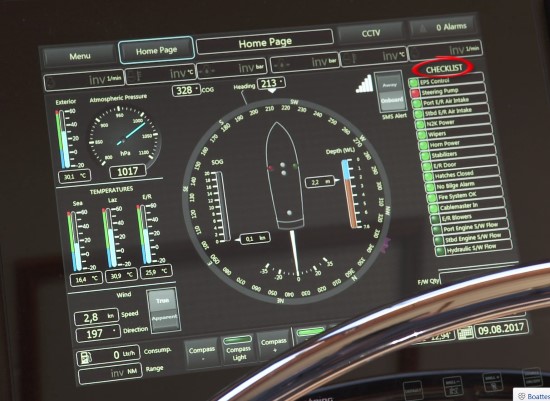
For ten years Fleming has been installing the “Boning/Fleming Monitoring System.” It is standard equipment on the Fleming 58 and in our opinion, no vessel that is going to be far at sea for prolonged periods of time should be without one. Note the “checklist” at the right; only one of its many helpful functions.
Boning/Fleming Monitoring System
This remarkable system of boat monitoring is the most sophisticated and all-encompassing monitoring system we have seen on a recreational motoryacht of any size, and used mainly on megayachts in addition to commercial vessels. Over 10 years ago Fleming worked with the engineers at Boning to create a system that was specially adapted to its boats and the kind of boating, and information, its owners needed.
Essentially, it monitors all of the vital signs of the boat, its engines, and its critical equipment. It monitors everything that dozens of conventional gauges, readouts and dials do on many motoryachts -- and many things that are not generally monitored. It has all of the information displayed on one 15” screen at both the lower and upper helms. Different pages are devoted to different aspects of the boat. All data points are recorded on a hard drive and can be viewed, or sent via the Internet to an outside location.
One of the most useful features is a checklist of things that must be ready for the vessel to go to sea, much like the check-off list commercial pilots have.
Early Warning
We think of this system as sort of a “DEW Line” (Distance Early Warning) for detecting potential trouble on the dozens of systems on the boat, before it gets out of hand. For example, it can sense problems such as dropping raw water intake pressure before engine temperatures start to spike in the engines. Owners can set alarms at points in the fuel and water tanks to notify them that certain levels have been reached.
A short list of just some of the things that it senses and reports on include: the engines, the generator, bilge and sump pumps, Seatorque shaft oil temperature, fresh water pressure and flow, doors open or closed, main engine seawater flow, and watermaker (if installed), among many other things.
Most important, it can monitor virtually everything in the engine room, and it, along with a TV camera and FLIR infrared camera, can give peace of mind to a captain who is short-handed. While it does not make trips to the engine room unnecessary, it can certainly cut down on the number and frequency.
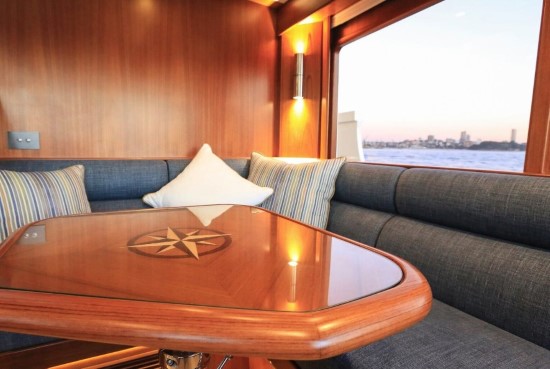
Behind the helm is a cozy L-shaped dinette with teak table on a pedestal. The table will be a slightly different shape if a companion helm chair is installed.
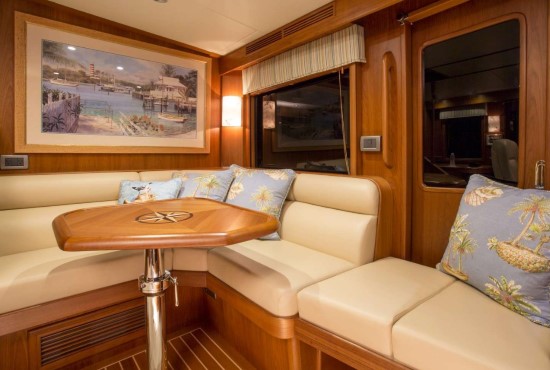
A bench seat is standard and it creates a berth for the offwatch when making long passages. Both pilothouse doors are sliding aluminum doors with wood on the inside, and gelcoated FRP on the exterior, and they slide in aluminum channels and have weather seals.
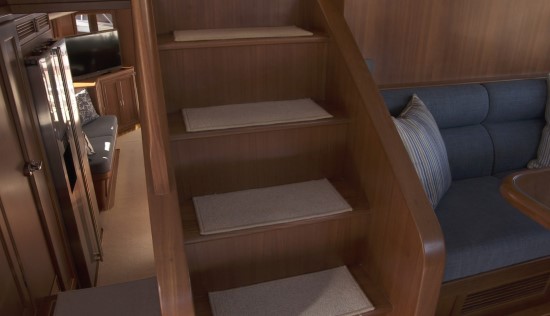
Behind the helm are steps up to the flying bridge at right and down to the galley and salon at left.
Accommodations

This is the layout plan of the Fleming 58 we tested, with some small differences. For example, note that in the master stateroom the vanity/deck and sofa have switched sides in some of the units pictured.
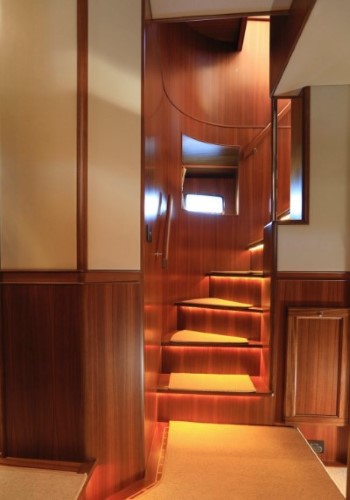
A spiril staircase leads below where there is over 7’ of headroom in the foyer.

The passageway to the staterooms has waistcoating with teak below the chair-rails and Ultraleather above.
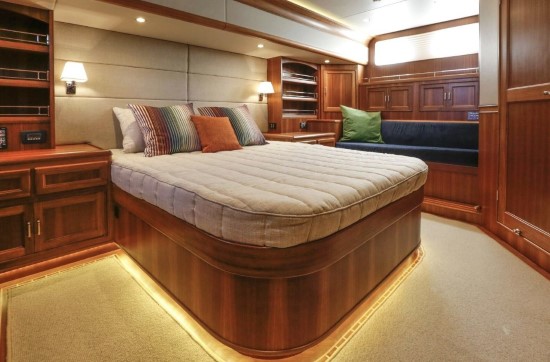
The master staeroom is aft and is bright and airy. The bed measure 67” wide and 76” head to foot. Headroom is 6’6”.
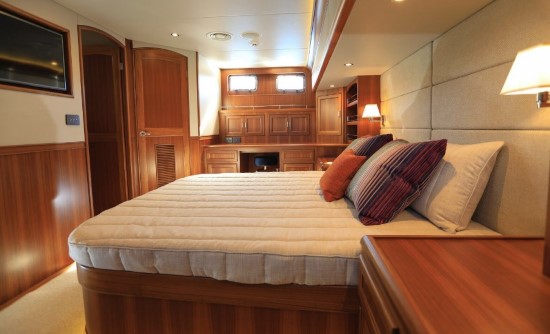
The master stateroom is full-beam and takes advantage of the boat’s 17’6” (5.33 m) width.
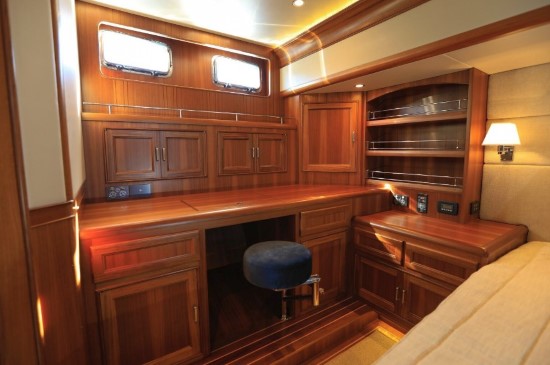
To starboard in our test boat was a built-in desk/vanity, storage cabinets and a bookcase. The deck was ¼” teak and holly over fiberglass composite substructure with honeycomb material for stiffening. Note the teak joinery work, which is superb throughout the boat.
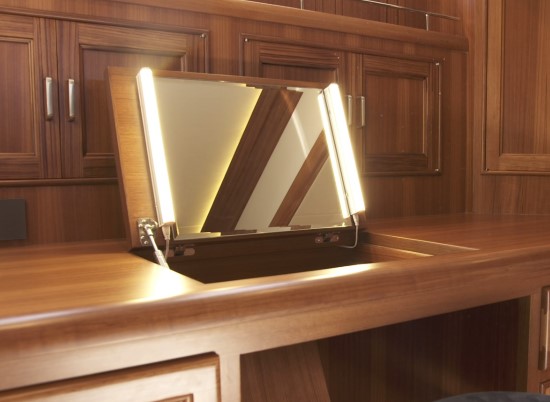
The vanity with light allows this space to serve double-duty.
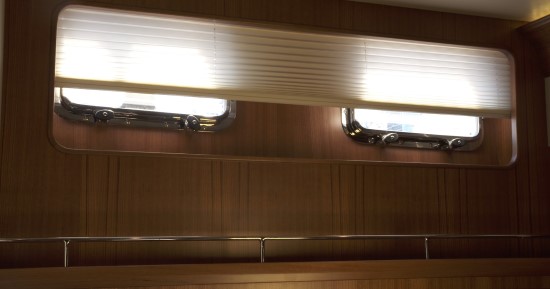
The Roman shades in the master are elecrically actuated by buttons near the bed.
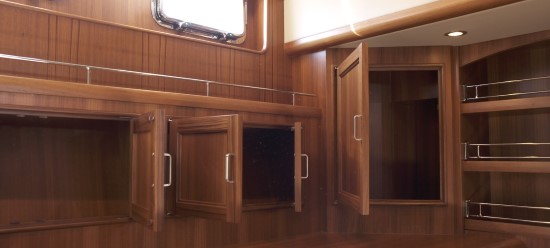
The master stateroom has storage in all available spaces.
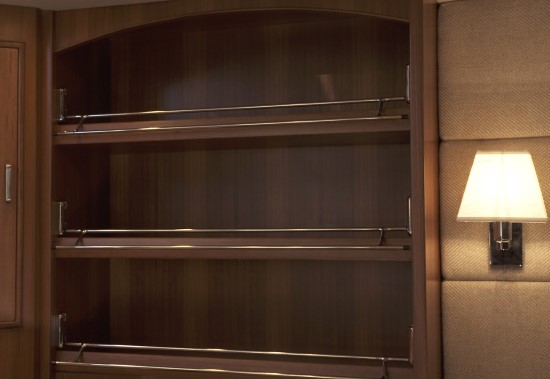
Fleming owners are, by their very nature, also readers. For that reason Fleming has installed a number of bookcases around the boat, the largest ones being in the master stateroom.

Fleming has devised clever fiddles for their bookcases. Polished stainless steel fiddles lift up and out to make it easy to add and retrieve books.
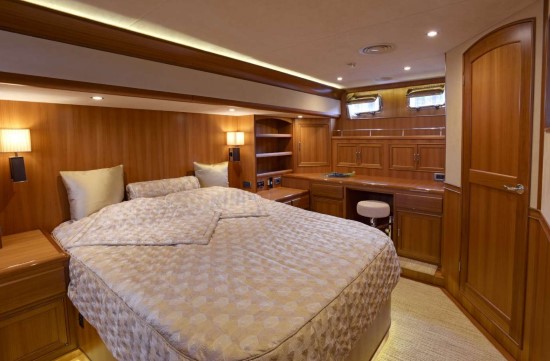
This is an alternate design scheme for the master stateroom with a teak bulkhead instead of the upholstered one seen on our test boat. Also, note that the desk and sofa have switched sides.

Looking forward we see the passageway door open and the door to the walk-in closet at right, closed. The waistcoating theme which is in the passage way is continued in the staterooms. The lower part of the bulkhead is teak, and the upper part is Ultraleather.

The master walk-in closet is to starboard. Note the opening port for fresh air.
Master Head

The master head has four mirrors, one full length on the door, and three on the outboard bulkhead. Behind these three mirrors is storage. The countertop and back splash are marble. The portlight opens.

The center mirror swings up and locks for shaving and appling cosmetics. This clever design provides light and a mirror at the proper height.
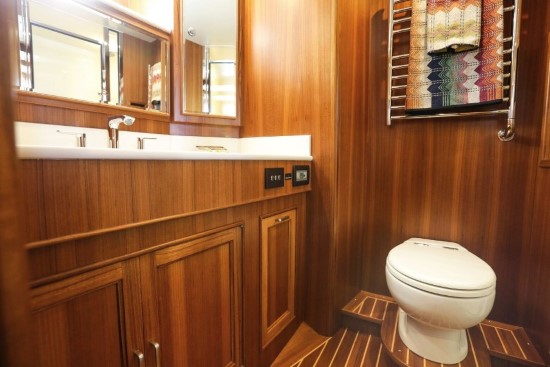
Guest Staterooms

Here we see the guest stateroom to port and the bow stateroom at right. Note all doors have clasps to hold them open.
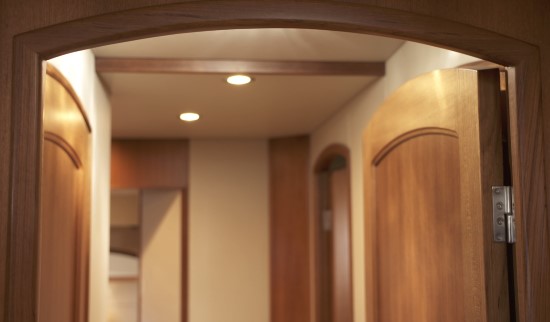
All doors in the passage way to the staterooms have arched lentels insead of square ones. We think this adds a classy look to the boat and it is certainly more expensive to build.

This is the undeside of the deck prism that we saw on the Portuguese bridge.
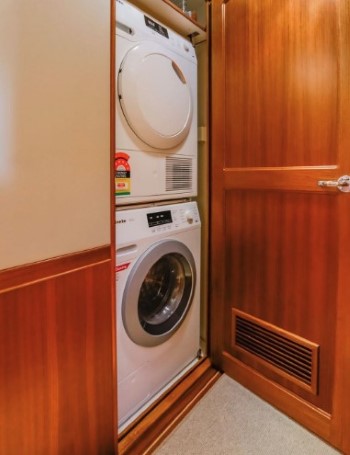
Stacked Miele washer and dryer units are housed just abaft the forward cabin. Separate units are better than the combos and are worth the extra space, in our opinion.
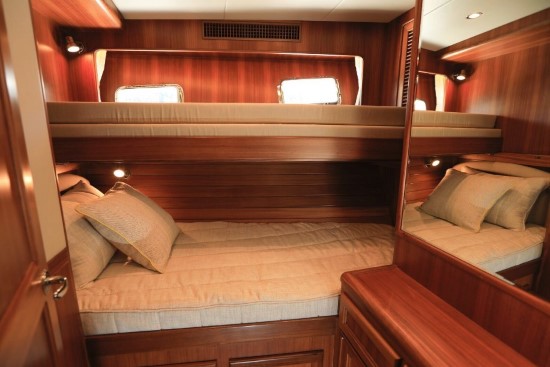
The Pullman berth above pulls out to form a full-width bed above. The Pullman can be reduced in width by half when the cabin is being used by only one person, thus creating more space and place to stow gear. This cabin is also offered with an office layout having a single berth above a desk.

Note the storage under the bed and in the cabinet at right. There is no hanging locker in this cabin.

Partial view of the forward stateroom which has twin berths port and starboard, the most comfortable arrangement for a bow stateroom. Because of the bow flare, Fleming is able to put bunks in this cabin to comfortably sleep four people. It is an ideal way for owners to accommodate children and grandchildren, and has been done with great success.

This wide-angle view of the forward cabin on another model, better shows its size and possibilities. The island berth is an option, but with it comes the obvious limitations. Headroom in both layouts is 6’7” (2.0 m). This layout has good-sized hanging lockers port and starboard.
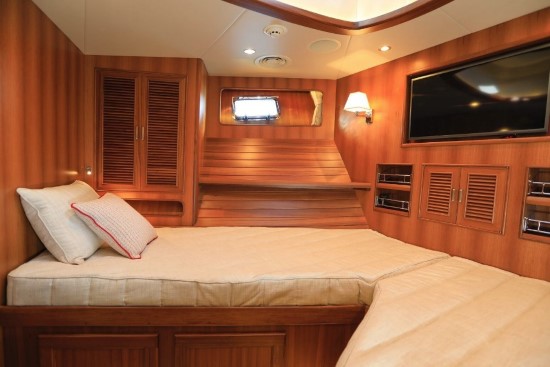
In our test 58 the forward bulkhead held electronic equipment, the TV and bookcases, in addition to the sconces. The forepeak has a watertight crash bulkhead.
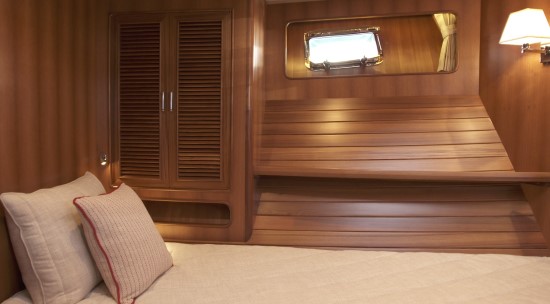
The portside berth with hanging locker behind. Each of the beds measures 34-1/2” wide by 90” long. They are extremely comfortable. The teak planks on the hull side give the cabin a cozy feel. We’d like to see taller fiddles on the outboat shelves, and perhaps another shelf higher that could be used for folded garments, such as polo shirts and sweaters.
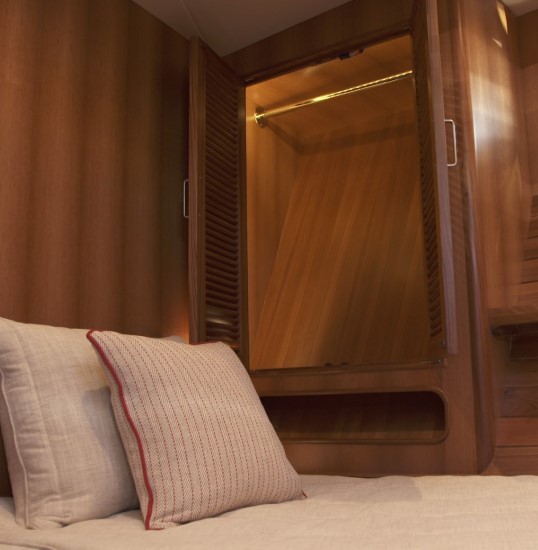
The hanging lockers are wide at the top and narrow at the bottom, a dimension dictated by the angle of the hullside. It seems to us that clothes need to be hung parrallel to the hull rather than at a 90-degree angle to it in this space. The hanging lockers are larger in the island berth layout. All boats are a compromise, and this is one of them on the 58.

In the starboard hanging locker we find an emergency egress ladder to use in order to escape through the forward hatch. This ladder is a wonderful idea, and we wish more boats had them. Forward escape hatches are required by ABYC standards and CE regulations.

Under the berths on each side are large, deep drawers. The bow thruster can be reached through a hatch in the cabin sole.
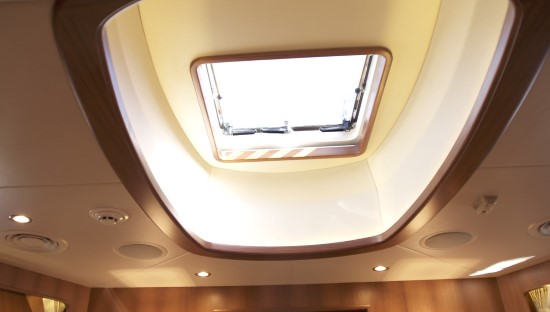
There is a dramatic soffit in the forward stateroom which makes it appear larger. It raises the 6’7” headroom another foot or so.
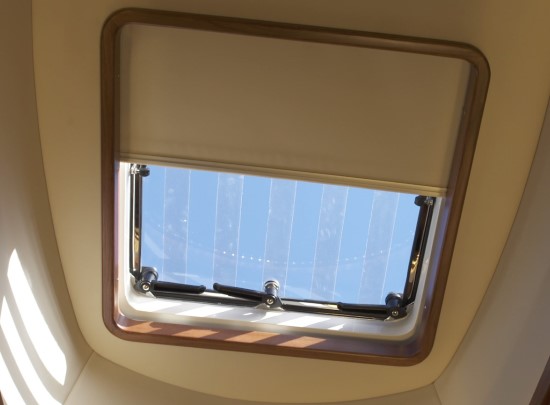
The hatch has electrically actuated sun shade and screen which are made by Ocean Air, the leading company for these fixtures.
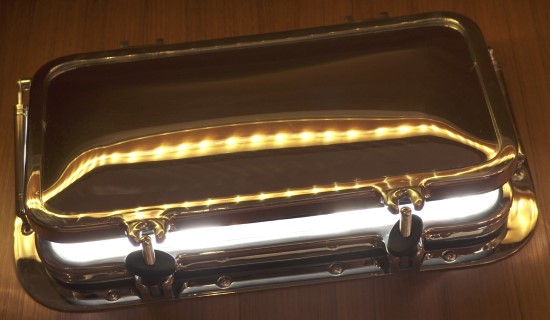
All portlights in the Fleming 58 have solid polished stainless steel deadlights that can be dogged down. These shutters are required for CE Ocean A certification.
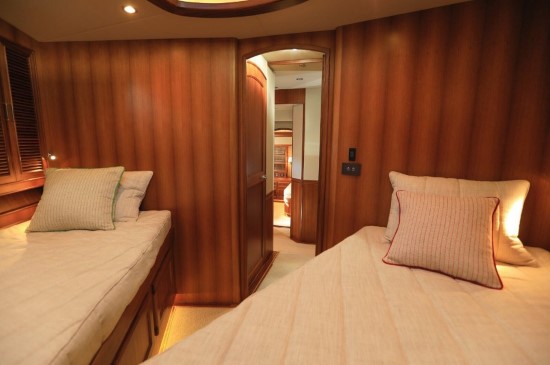
View from the forward end of the cabin, looking aft. As can be seen, there is plenty of room to add bunks in this cabin. We have seen vessels fitted out that way and they are suprisingly roomy because of the bow flare. Downside is that the hanging lockers disappear.
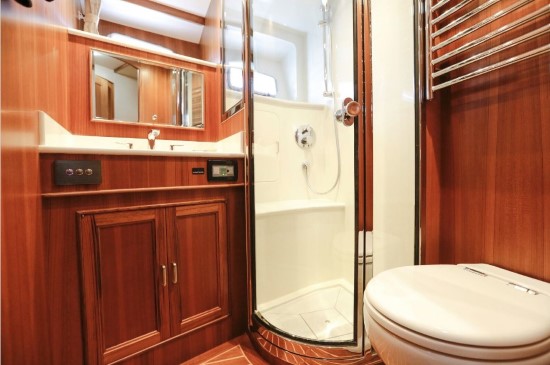
The guest head in our test boat showing the separate shower stall with curved glass door with a polished stainless steel frame. The shower has a marble deck and a bench.
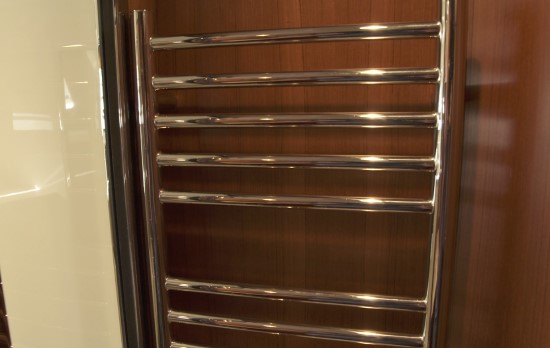
Heated towel racks make use of the constantly circulating hot water in the boat and saves using the energy-hungry dryer. Plus, the towels always feel warm and toasty.
Side Decks

Look closely and see the Plexiglas wing door that keeps wind and spray out of the cockpit. The side deck is 20-3/4” wide and the passage is slightly wider higher up. The bulwark is 26” high aft and rises to 36” forward. Note the handrail on the side of the house and the full beam overhang overhead. The deck layout is symmetrical.

There are port and starboard doors in the bulwarks on the main deck which open in and aid boarding from a dock. Note the wing door at left out of focus, and the three steps up to the Portuguese bridge. Teak decking is standard on the side decks and on the steps on the Portuguese bridge.
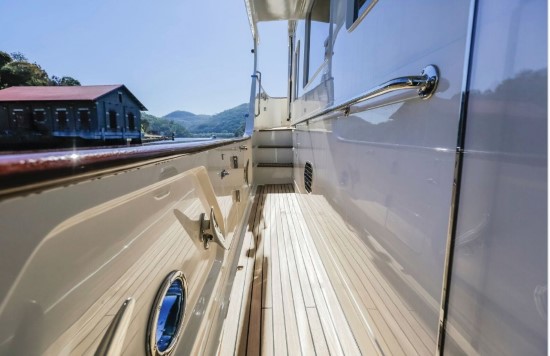
The port side deck: note the amidships hawes holes and large cleats for spring lines, rafting up, moorage of all kinds.
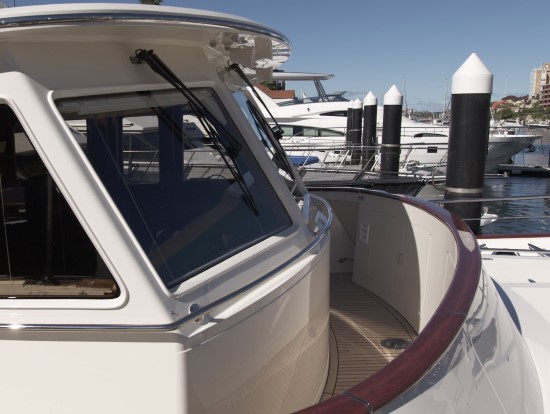
The Portuguese bridge has a wide passageway from port to starboard which alows the crew to move from side to side in sloppy conditions with safety. Note the deck prism on the centerline which brings light below. The windshields are 8 mm thick and the three winshield wipers are pantograph style. There is storage in the forward bulwark.
The Bow
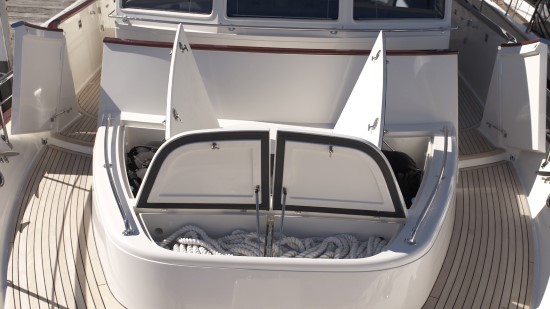
The Portuguese bridge has port and starboard doors leading to the foredeck. The bins in the trunk cabin come in handy stowing fenders and mooring lines. All compartments are vented and drain overboard. Note the rubber gaskets on all hatches. Standard decking here is gelcoated fiberglass with a non-skid pattern.
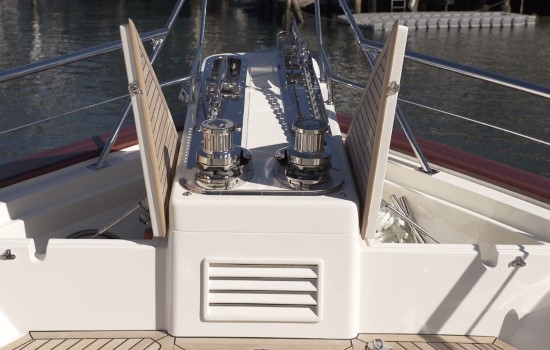
Twin 24v DC Maxwell RC12 windlasses with pendant control are standard, along with remotes at both helm stations. One 100 pound stainless steel Ultra anchor with 300’ of 7/16” ACCO hi-test galvanized chain is standard. The second anchor and ground tackle are optional.
Which Windlass? The 58 we tested was equipped with the optional hydraulic windlasses. When deciding which way to go on windlasses – electric or hydraulic – there are two points of view: electric is less expensive, and faster. But, if it is overloaded or used too much it can overheat and set off the breaker, and since it is electirc, it is potentially vulnerable to saltwater intrusion because of its location.
Hydraulic windlasses are much more reliable and heavy-duty. They won’t overheat and there is no breaker to throw. On the 58 we tested, one windlass is powered hydraulically, and the other electrically. The hydraulic system is backed up with two PTOs so if one failed, there was a second source of power. The best of both worlds.

The locker to port of the bow pulpit is rigged with both raw and fresh water washdowns.
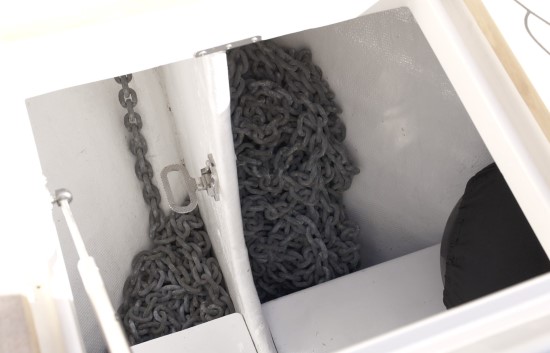
Anchor lockers are more important than most people realize. After several hours of plunging up and down in rough seas the anchor chain can become hopelessly entangled. That is why it is important to have a large hatch so the operater can get down in the locker and untangle them. Note the step in the port locker. These lockers drain overboard.
The Flying Bridge
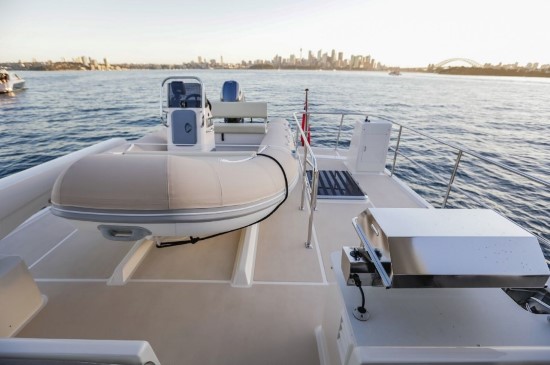
The boat deck on the Fleming 58 can easily handle a 13’ tender with outboard, which is usually large enough for four people. The hydraulic davit at left is a Steelhead ES 1000. Note the optional remote control console on the starboard quarter.

View forward on the flying bridge. The console at left has a refrigerator, sink, and optional BBQ.
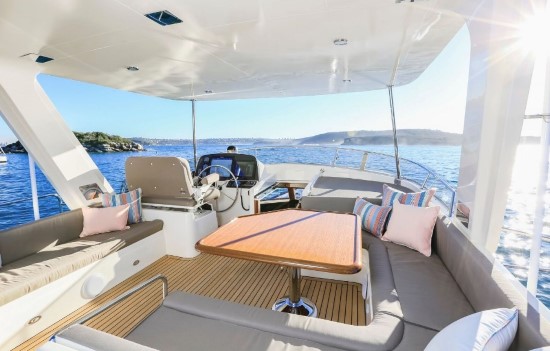
General view of the flying bridge. Note the double-wide helm seat for two at left, the large C-shaped dinette and the bench seat to port.

The owner can pick any upholstery fabrics wanted. The owner of the 58 pictured here obviously wanted a more tropical look. Even though the Fleming 58 is a rugged long range cruiser, she has plenty of space on the flying bridge for entertaining. Launch the tender and even more space is available aft.
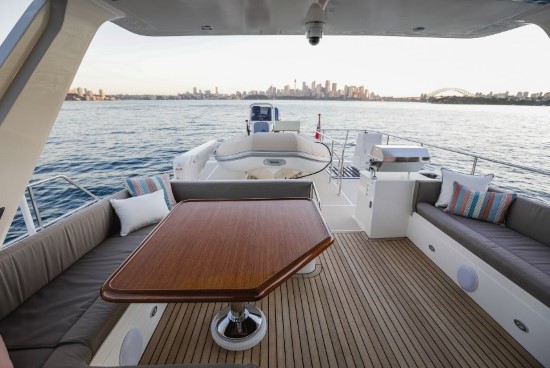
The hardtop is an option that we recommend because it can add so much utility to the boat or a relatively small amount of money. We’d button it up with isinglass for three season boating.

The flying bridge helm is a scaled-down version of the lower helm. All the information needed can be accessed on two screens: the multi-window nav screen and the one for the Boning/Fleming system.
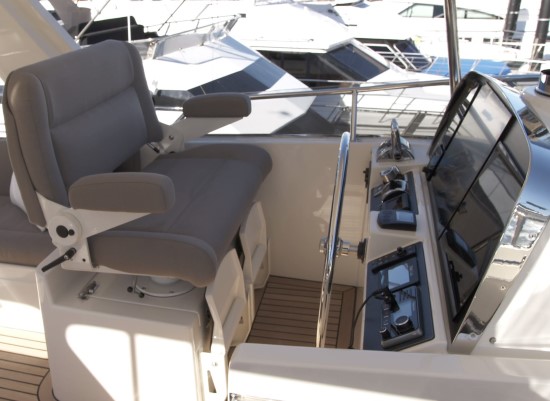
Two Stidd footrests are folded up out of the way in this image. We like the seat anchored to the fiberglass support instead of the two long pedestals that are stressed in sloppy conditions.
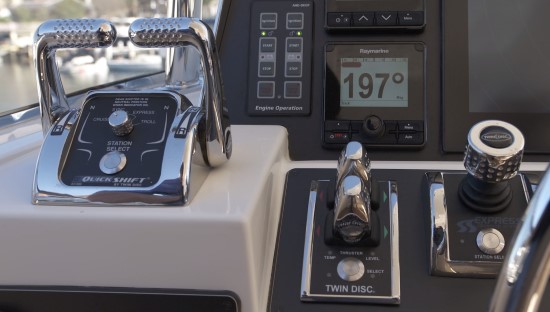
The Twin Disc controls shown here are identical to the ones at the lower helm. A Twin Disc Quick Shift marine gear is used for the reason that the joystick and bow and stern thrusters are all tied in together. Use the joystick or the thrusters and engine controls. The hydraulic bow and stern thruster on this boat were up-graded by the owner to 38-hp and 25-hp, respectively. The joystick at right controls both of the thrusters and the mains for precise maneuvering. The Twin Disc System on this boat also included an impressive position hold feature; press a button on the Twin Disc display panel and the system automatically controls both shafts, and both thrusters to hold heading and GPS position. A very useful feature, especially when short-handed.
Engine Room
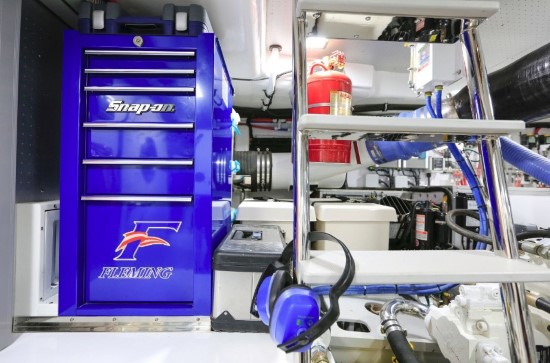
The engine room is entered from the cockpit down the ladder shown here into the lazarette.

Our test boat was powered by twin i6 MAN 800-hp engines. The engine room has 71-1/2”(1.81 m) of overhead clearance which makes it quite comfortable to work in. There is 21” between the engines and it is possible to get to the outboard side of the mains.
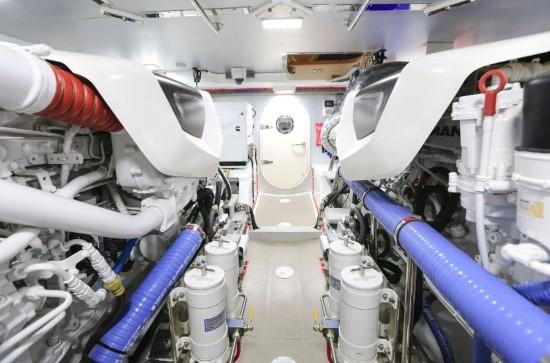
Looking aft toward the watertight door to the lazarette. The blue hose is made by Trident and is commercial grade manufactured with multiple layers of rubber and other materials to withstand very high temperatures without degrading and becoming brittle.
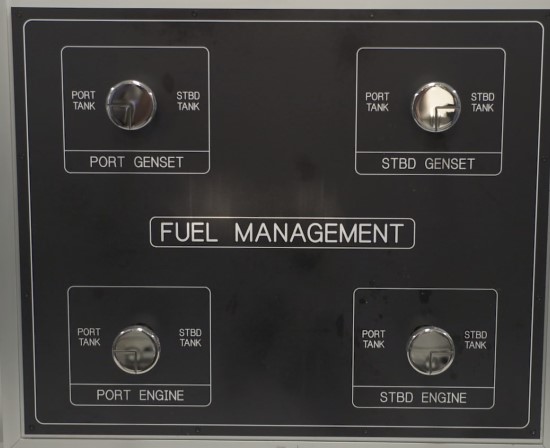
The fuel management system could not be easier to figure out. Fuel is drawn from either the port or starboard tank for either the mains or the generators.

The solenoid-operated sight gauge for one of the two 725 gallon (2,744 L) fuel tanks. Note the black strip indicates fill levels. By placing the athwartships forward of the engines about where the longitudinal CG is located they keep the boat trim about the same as fuel burns off. They also serve as an addditional sound barrier between the engine room and the accommodations area. The water tanks have sight gauges as well.
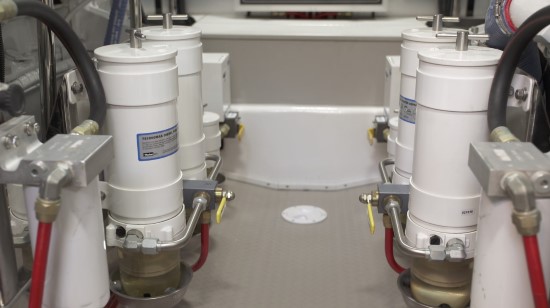
The four Racor fuel filter/water separator units seen here are model 1000 which has a 180 gph flow rate and an “Aquabloc” 2 micron filter element. A single twist of the fitting on the bottom of the see-through bowels drains off water. The MAN engines are common rail and most of the fuel is retuned to the tank. As a result the fuel is constantly cirulated through these filters and “polished.”
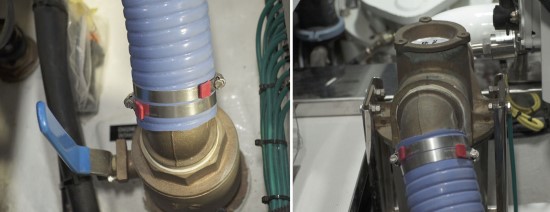
Raw water for main engine cooling is drawn through its own dedicated seacock which is easy to reach...as is the Groco sea strainer just forward of the engine. Note the rubber guards on the hose clamps to avoid cuts.
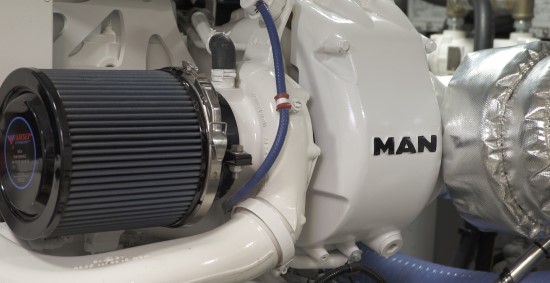
These MAN engines have dry turbos with water jackets around them for cooling, which increases their performance and reliability. It is one of the reasons that Fleming selected these engines.

Another reason the MANs were selected is because of their radiator which uses plates instead of tubes. We were told that this design reduces the chance of corrosion. Note the sight gauge to see the water level in the engine which means the radiator cap does not have to be opened for fluid checks, and it can be checked while running.
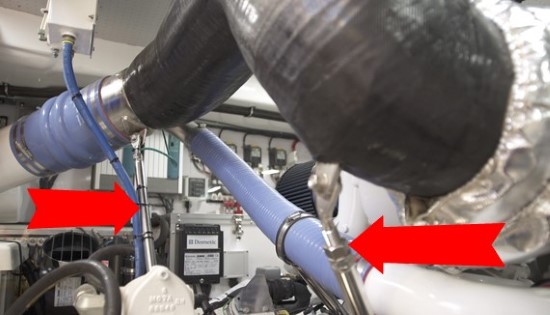
There are two supports for each exhaust riser, something that is critically important to keep the exhaust fitting firmly in place on the turbo on rough conditions. Both are connected to the engine as they should be, and not the hull.
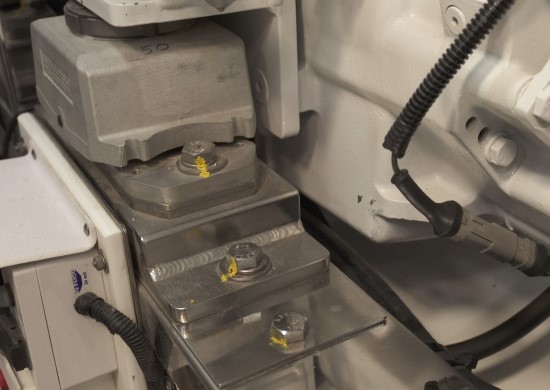
Fleming has fabricated extremely stout engine mounts with 6 bolts on each mount going through a steel rail embeded in the fiberglass stringers. The four robust rubber bushings on each engine along with the Seatorque drive system, virtually eliminates vibration on the boat. This together with the sound insulation in the engine room make the operating extremely quiet. In the pilothouse we recorded only 64 dbA at 10 knots cruising speed.
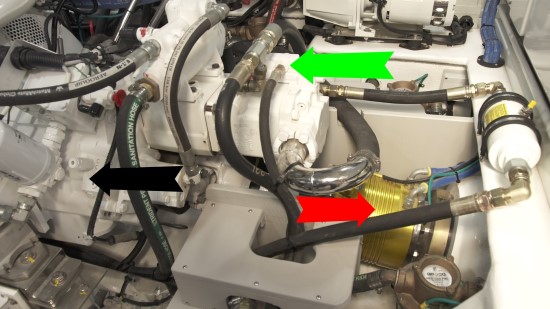
At the business end of the MAN engines there is a lot going on. The black arrow points to the Twin Disc Quick Shift marine gear which takes commands from the controls and the joystick. The green arrow points to the power take off pumps which activate hydraulic fluid to the stabilizers, thrusters and windlasses. The red arrow points to the Seatorque system which is bolded on the frame at right.

Seatorque Bolt On Shaft System (BOSS™) as seen in this promotional image. The yellow section at right contains the thrust bearings which take the load to the boats frame and not to the marine gear and engine. Inside the white housing is the 3” drive shaft which is immersed in oil. The casing is connected to the strut where the yellow section is at the left.
Seatorque Reduces Vibration. The Fleming 58 is equipped with the Seatorque M4 BOSS “Bolt On Drive System” which couples the output from the marine gear with a 3” ss prop shaft that is totally isolated from the marine gear and engine. This drive system is bolted to the stringers and frame of the boat, and a thrust bearing assembly transmits the force directly to the boat, not to the engine.
This design, which has the prop shaft turning in a totally enclosed, oil-filled casing, virtually eliminates vibration. It also eliminates the need for cutlass bearings on the shaft and a stuffing box or dripless shaft log. There is no need to precisely align the engine with the shaft with this system.

The 58 standard equipment includes ABT TRAC stabilizers mounted in the engine room and is easily accesible. The system has 7.5 sq.ft. fins with winglets. Fleming prefers conventioal fin stabilizers to internal gyro stabilizers because they say that gyro stabilizers are not affected over 5 knots of boat speed.
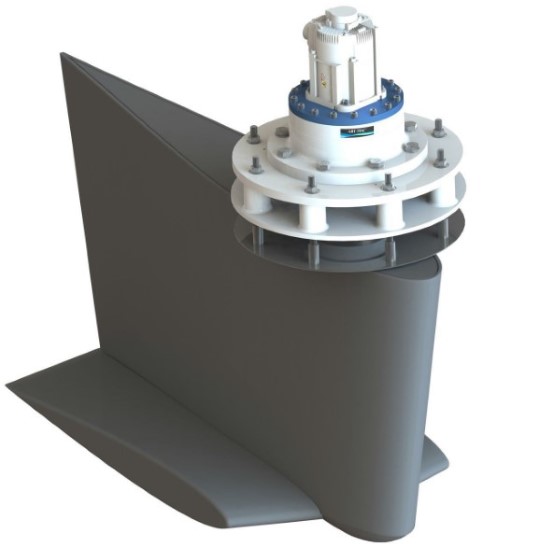
The ABT TRAC stabilizer has “winglets” that take advantage of what is called the “End Plate Effect” for greater efficiency, much like the up-turned wing tips seen on the latest commercial airliners.

The Onan 17 kW 60Hz generator is double mounted on six anti-vibration isolation mounts, to reduce generator vibration and noise. The red arrow is pointing to the Wilkes & McLean hydraulic noise suppressor that is hooked up to the stabilizer hydraulic hoses. This system greatly reduces stabilzer noise when they are working hard.
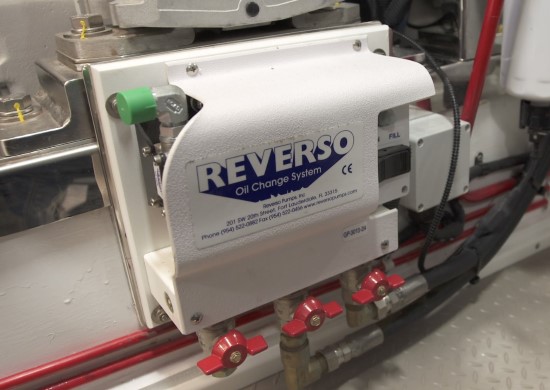
No owner/operator should be without a Reverso oil change system. The Fleming 58 has two – one for the port engine, gear and generator, and a second for the starboard engine, gear and generator. This unit can quickly change oil from both the MAN and Onan engine sumps and replace the oil without a spill. It is self-priming. Its flow rate is 3 gpm (11.35 lpm).
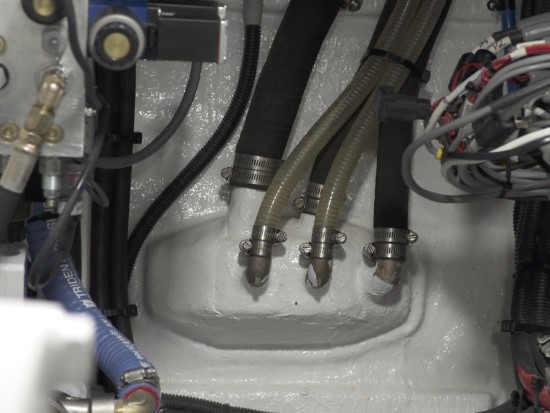
Fleming directs multiple drains to one discharge manifold at several points on the boat, thus reducing the number of holes in the hull.
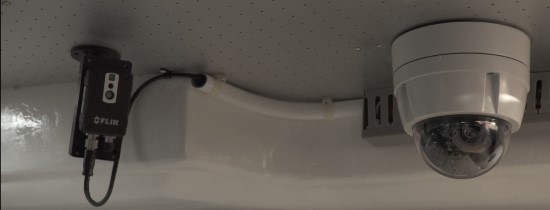
At left is a FLIR AX8 thermal imaging camera for continuous condition and safety monitoring with a thermal sensor with imaging capabilities. It can activate an alarm when certain pre-set temperature thresholds are exceeded, and also provide a temperature trend analysis. The conventional camera at right can be adjusted to focus on different parts of the engine room.

This Dometic Cruisair air conditioner unit pumps cold air into the engine room to make it suprisingly hospitable just a few minutes after shutting down. All inside living spaces are supplied with Cruisair reverse-cycle air conditioning with REU model quiet blowers and Qht controls.
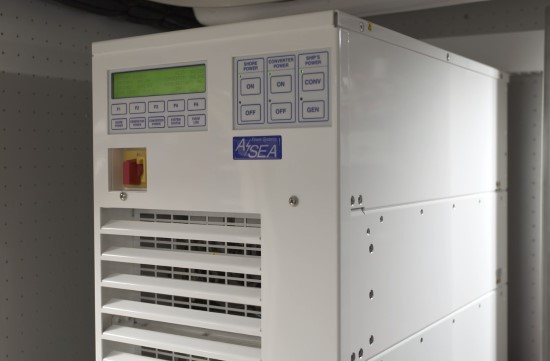
Moving from the engine room into the lazarette, the head room drops to 4’6-1/2” which is not bad given the low profile of this boat. Here we find a number of important pieces of equipment. Our test boat was equipped with an A/Sea frequency converter which is absolutely necessary for anyone planning on cruising to the Carribean, the Far East or Europe -- and using shore power. Only about 20% of the countries use 110-120 V and 60Hz power. Most use 220 V and 50Hz. The A/Sea frequency converter seen above accepts shore power ranging from 170-520 V and 40-70Hz and converts it to whatever the equipment aboard uses. It also protects the boat’s equipment from shore-supplied power surges and can also boost power somewhat. All Flemings have ASEA frequency converters as standard equipment.
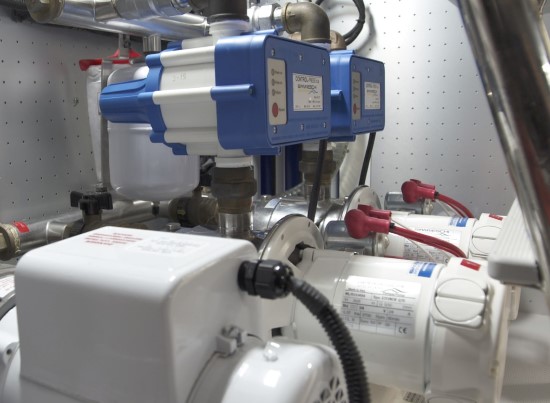
Fleming installs in the laz two 24 V DC Gianneschi fresh water pumps to have redundancy. They are connected to the two polyethylene tanks that total 320 gallon (1,211 L). While the boat has a 20 gallon (75 L) Torrid 22V AC electric water heater, it also has a heat exchanger on the port engine and cirulation pump plumbed to the hot water system.
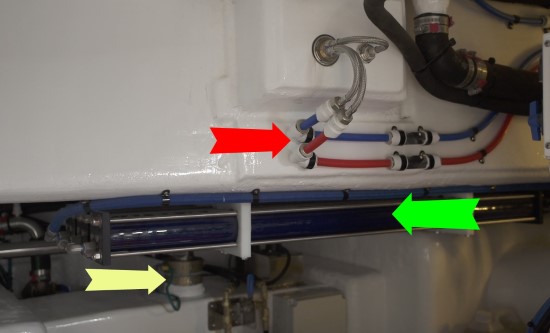
Looking aft from the lazarette to the section under the swim platform, we see a number of things. The red arrow points to the hot and cold water lines and outlet in the transom for a shower. The green arrow points to the fiberglass reverse osmosis tubes for the FCI Watermaker. The yellow arrow points to the rudder stock which has a tube that extends above the waterline.
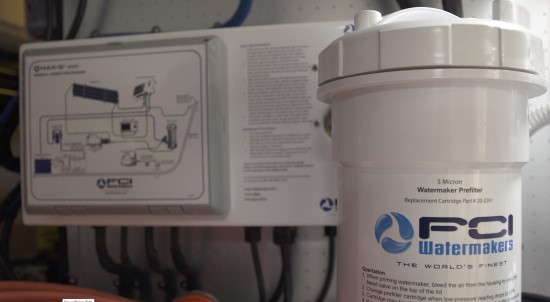
Nearby in the lazarette is the FCI Watermaker, which is rated at 1,800 gpd. This is a smart choice as it reduces the time that the watermaker has to work to keep the water tanks topped off. If the water tanks were empty, theoretically this watermaker could fill them in just over four hours. Since all reverse osmosis watermakers are noisy, that is a perfect amount of time. When owners are ashore or out in the tender, the watermaker can be on, topping off the tanks. With six people aboard taking showers all day and the washing machine working, plus the dishwasher running, the ship’s 320 gallons (1,211 L) of freshwater can be depleated quickly. When out in the islands, it is probably more handy to make freshwater aboard.
Price
Base Price with standard i6 800-hp MAN engines is $2.9 million.
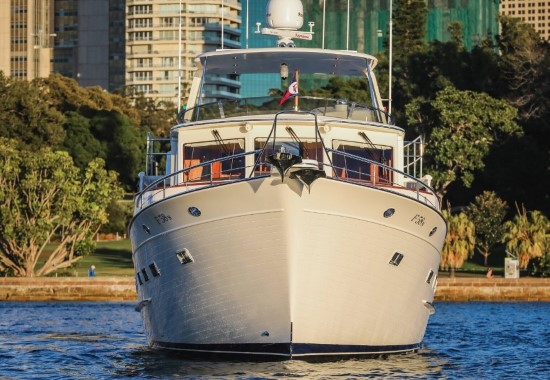
The Fleming 58 is a design and a boat that signals to all other boats in the harbor that her owner means business — serious cruising business.
Observations
Our test boat was fitted out with redundancies almost everywhere possible. Money for useful equipment was no object for the owner of this vessel. We are hard pressed to come up with anything this boat lacked. She was one of the best-equipped boats we have ever tested.
A lot of the equipment added was expensive and depending on the owner and the use of the boat, perhaps not necessary. For example, the hydraulic system alone cost $160,000 extra. For most boat owners, electric anchor windlasses and thrusters would be adequate.
But of course, Fleming owners are not just any boat owners. By the time they have gotten to this stage in their boating experience, they have a keen idea of what is needed for the work they want to do. The owner of this boat is prepared for some serious long-distance traveling.
As thorough as this report has tried to be, it does not touch on dozens of other aspects of the boat that are important. For example, the boat comes standard with “eFIT” (an Electronic Fleming Information Tablet). It is an iPad with all technical documentation on it, the owner’s manual, wiring diagrams, systems descriptions, etc. And each engine has two alternators, one brushless, producing as much as 200 AMPs. The fuel tanks and water tanks can be fueled from either side of the boat.
Engine room air comes in through plenums under the cockpit cap rail into the lazarette below and then through vents into the engine room, thus getting the salt and any spray dispensed with before entering the inner sanctum. This simple design eliminates the need for expensive demisters in the engine room. The list goes on and on about this remarkable design and the equipment that has gone into the Fleming 58.
All of this is in a design that is very easy on the eyes. She is truly a benchmark — and a high bar — for all boats in class.

